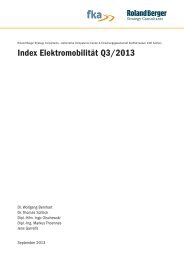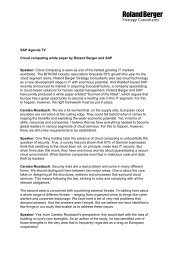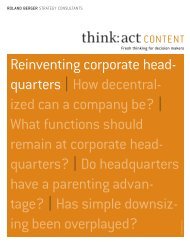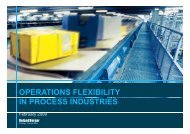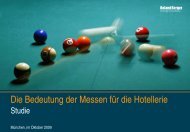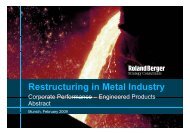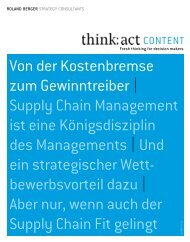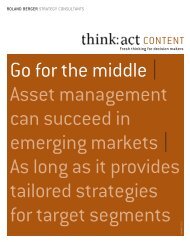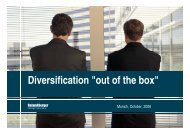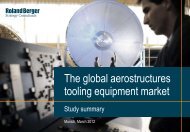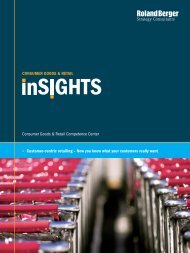"Automotive inSIGHTS 2/2010" (PDF, 3784 KB - Roland Berger
"Automotive inSIGHTS 2/2010" (PDF, 3784 KB - Roland Berger
"Automotive inSIGHTS 2/2010" (PDF, 3784 KB - Roland Berger
Create successful ePaper yourself
Turn your PDF publications into a flip-book with our unique Google optimized e-Paper software.
AUTOMOTIVE 2025<br />
Trends in the emerging markets and the mature economies<br />
are diverging, along with the implications for OEMs/<br />
OESs. Take VW Mexico, for example: here you find two<br />
separate business organizations in one, with one making<br />
vehicles for the local market and the other for export.<br />
4. General thoughts<br />
Some of our findings do not fall into a specific cluster<br />
but are more generally applicable.<br />
A. First of all, the automotive industry needs to open<br />
up and be able to learn from other industries. From<br />
the IT industry, for one. The increasing amount of electronics<br />
in the cars, the necessary compatibility of cars<br />
with other electronic devices such as smart phones, and<br />
mobility concepts of the future will mean the automotive<br />
and IT industries will need to grow together. But the two<br />
industries could hardly be more different.<br />
> Six-month life cycles on the one hand, versus<br />
four to six years on the other<br />
> The philosophy of letting the customer test beta<br />
version products versus 36 million km testing<br />
the Mercedes E-class before market launch<br />
> Lean hierarchies in which innovations can rise<br />
quickly versus extremely formal hierarchical<br />
business organizations<br />
> Video conferencing as an integral part of daily<br />
business communication routine versus a<br />
"being there" meeting culture<br />
Then there are the utilities, for example, which have also<br />
faced changes in what people want from their products. To<br />
quote Ruth Werhahn, project manager at E-Mobility@EON:<br />
"The automotive industry now is where the utilities were<br />
a few years back, when renewable energy arrived."<br />
B. Size matters: In the automotive business, investing<br />
heavily in R&D is the key to lasting success, which is why<br />
the industry has been consolidating and companies have<br />
been getting larger for years. VW Group, for example, has<br />
been expanding its portfolio of brands.<br />
As markets change, new players will emerge who can<br />
use new business models, new technology and innovation<br />
capability to stay ahead of the competition in the short<br />
to medium term. We can expect this, in particular, at<br />
the interface between OEMs/OESs and utilities and<br />
the IT industry.<br />
In the medium to long term, however, critical size is essential.<br />
We expect things to go much the same way as with the dotcom<br />
companies, in which players of the necessary size have gained<br />
the upper hand in each segment in just fifteen years. And 2025<br />
is fifteen years away, too! The question is whether the OEMs will<br />
let this happen, or whether they will try and integrate promising<br />
new players as they emerge? We can already see partnerships up<br />
and running as a precursor to integration (Tesla with Toyota and<br />
Daimler, BYD with Daimler and VW).<br />
C. The survival of the most flexible: In 2025, successful<br />
businesses will be those that are most flexible in terms of<br />
> The organizational structures they use<br />
> The segments they cover<br />
> How they structure their partnerships, and for how long<br />
> Regional setup<br />
> Business models<br />
As we look at how the five megatrends are affecting the three<br />
clusters, combined with the general observations noted above,<br />
it is perhaps not an overstatement to say that the automotive<br />
industry is entering a new era. Although we have a good idea of<br />
where we are at the present, how these trends and developments<br />
play out over the next decade and a half remains to be seen. As<br />
the work on our study progresses, we will be mining more specific<br />
forecasts and conclusions, and we look forward to sharing our<br />
findings with you.<br />
Wolfgang Bernhart<br />
Partner,<br />
<strong>Roland</strong> <strong>Berger</strong> Strategy Consultants, Stuttgart<br />
wolfgang_bernhart@de.rolandberger.com<br />
Dr. Marcus Hoffmann<br />
Principal,<br />
<strong>Roland</strong> <strong>Berger</strong> Strategy Consultants, Munich<br />
marcus_hoffmann@de.rolandberger.com<br />
philipp Grosse Kleimann<br />
Senior Advisor,<br />
<strong>Roland</strong> <strong>Berger</strong> Strategy Consultants, Frankfurt<br />
philipp_grossekleimann@org.rolandberger.com<br />
17



